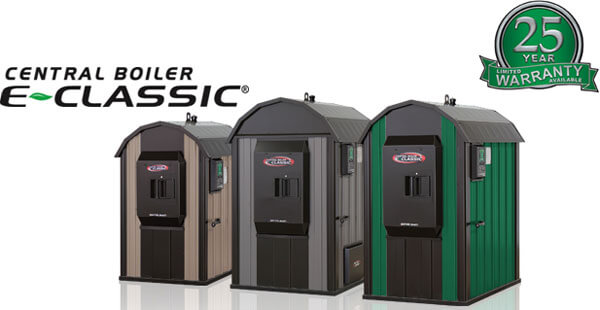- Home
- Wood Stove Guide
- Wood Burning Boiler Stoves
Wood Burning Boiler Stoves
This post may contain affiliate links so I earn a commission.
Wood burning boiler stoves can supply all of your heating needs.
They bring together some of the best qualities of wood heating with the convenience of providing central heat and hot water for your home or business.
Installing a boiler stove outdoors is relatively straightforward with minimal work needed inside the home to connect it.
For home and shop owners with an available supply of firewood these are an evolution in convenience and ease of use over traditional wood heating.
Lugging wood inside your home is something that anyone who has a wood stove or fireplace is unlikely to miss.
Cutting, stacking, and restacking will keep you warm, but it is a real time consumer.
 Northland Outdoor Wood Furnace
Northland Outdoor Wood FurnaceOutdoor wood burning stoves can be outside near your existing stack of firewood, and they are much less picky about what you feed them.
Clean softwoods traditionally considered unfit for burning inside a wood stove or fireplace are fine as well as the traditional hardwood firewood.
With the ability to fell your own trees to process into firewood, or even buy logging truckloads (also known as a pulp cord) of low quality wood that traditionally would not be used as firewood, you can get your heating costs way down.
Wood Burning Boiler Stoves - Burning Softwoods And Hardwoods
As an example.....although it's been several years ago, I was able to buy a pulp cord of poplar for $60 a full cord.
The wood was in 8 foot lengths and needed to be cut up, but at such a low price I couldn't pass it up.
Normally I wouldn't mess with paying money for poplar, but since an outdoor wood stove will burn logs that haven't been split, the wood lasts a decent amount of time inside the stove.
I would also burn a lot of red pine inside my stove because they were constantly getting blown over during storms.

That statement alone will make anyone with firewood experience cringe because red pine is not a good firewood choice, but since the stove is located outside and away from your home, creosote buildup is not really a factor.
Anytime you heat with firewood there is going to be more work involved than if you just buy oil or propane, but the cost and environmental impact of locally sourced and sustainably harvested firewood is much lower.
All things considered, it takes less work to heat a home with an outdoor wood burning boiler stove over traditional wood heating methods.
Wood Burning Boiler Stoves - Modern Technology
Outdoor wood burning boiler stoves like the E-Classic from Central Boiler offer a lot of conveniences to make your life easier.
The E-Classic even offers something for the tech minded with the option of being able to check current and past performance data on your phone or computer.

Automatic gas ignition is another option making starting the E-Classic as easy and consistent as possible.
This adds a dimension to wood heating that was not really possible in generations past, the ability to be away from your home or business for extended periods of time and come back to a warm heated building.
Indoor Wood Boiler Stoves
Wood burning boiler stoves do not just have to be for the outdoors.
High efficiency boiler stoves, like the ones from Tarm, can give you the same efficiency and convenience as outdoor wood fired stoves, only they're located indoors.
They connect to a standard chimney flue and need about the same effort to use as a traditional wood stove.
Since they utilize your homes existing chimney, you do need to be conscious of the firewood you burn to help reduce creosote compared to the outdoor models.
If you live somewhere that has extreme winter cold, it might be worth considering installing an indoor unit for your heating needs.
They can even be placed in outbuildings to provide heat to multiple buildings onsite.
Installing Wood Burning Boiler Stoves
Every wood burning boiler stove has its own requirements for installation.
As a general rule this means the boiler needs to be provided with electricity and wired in, as well as connected to the heat and hot water for your home.
Typically, a circulation pump will move the heated water from the stove through a heat exchanger that's tied into your home heating system.
The process sounds more complex than what it really is.
Plus, it doesn't matter if your home has forced air or hot water baseboard heat.
An outdoor wood stove can handle either option.

Picking your site location is an important part of installing a wood burning boiler stove.
You will want to consider the convenience of operation, where your wood will be stacked and access to that part of your yard.
If you're going to buy firewood by the pulp cord and have it delivered on a semi, you'll want it dropped off near the stove and your wood shed to make it easier to handle.
Also consider the prevailing wind (if any) on your site.
Some of the older stoves can create a lot of smoke and you don't want the smoke blowing directly towards your home.
Wood Burning Boiler Stoves - Overall
Installing and operating a wood burning boiler stove is a big project.
While the average homeowner may be able to do some of the sitework involved, in many areas they cannot legally do the electrical or plumbing work required for installation.
For that reason it will be important to most homeowners not only to find a model that they like, but also to find a contractor who is qualified to install and do any needed maintenance and repairs.
Overall, wood burning boiler stoves are part of a sound energy independence strategy.
They produce efficient and reliable heat and hot water when you need it.

About the Author
Obsessed with firewood, Nick is behind over 350+ of Firewood For Life's articles, as well as countless reviews, guides and YouTube videos to help readers like you reduce heating costs and create the perfect fire.


